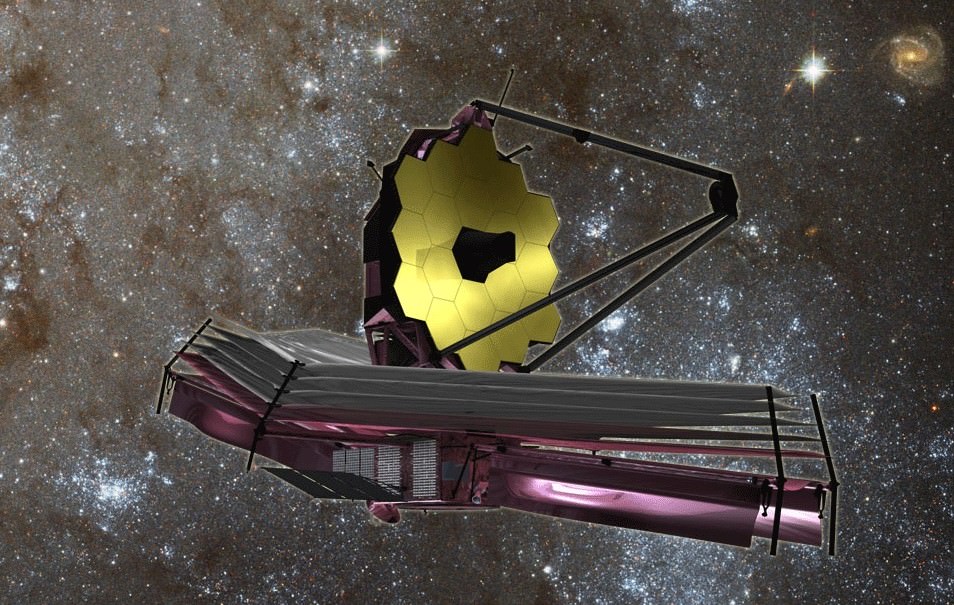The future of NASA’s human space flight looks exciting and bright in this new video. Only time will tell if the ISS program, COTS, CCDev2, Orion and SLS can come together to create the perfect storm of what could be an incredible future. Great expectations? You bet. But isn’t that what NASA is all about? Now if Congress can just get that message and figure it out.
Tropical Storm Lee Drenches Gulf Coast as Hurricane Katia Aims for US East Coast
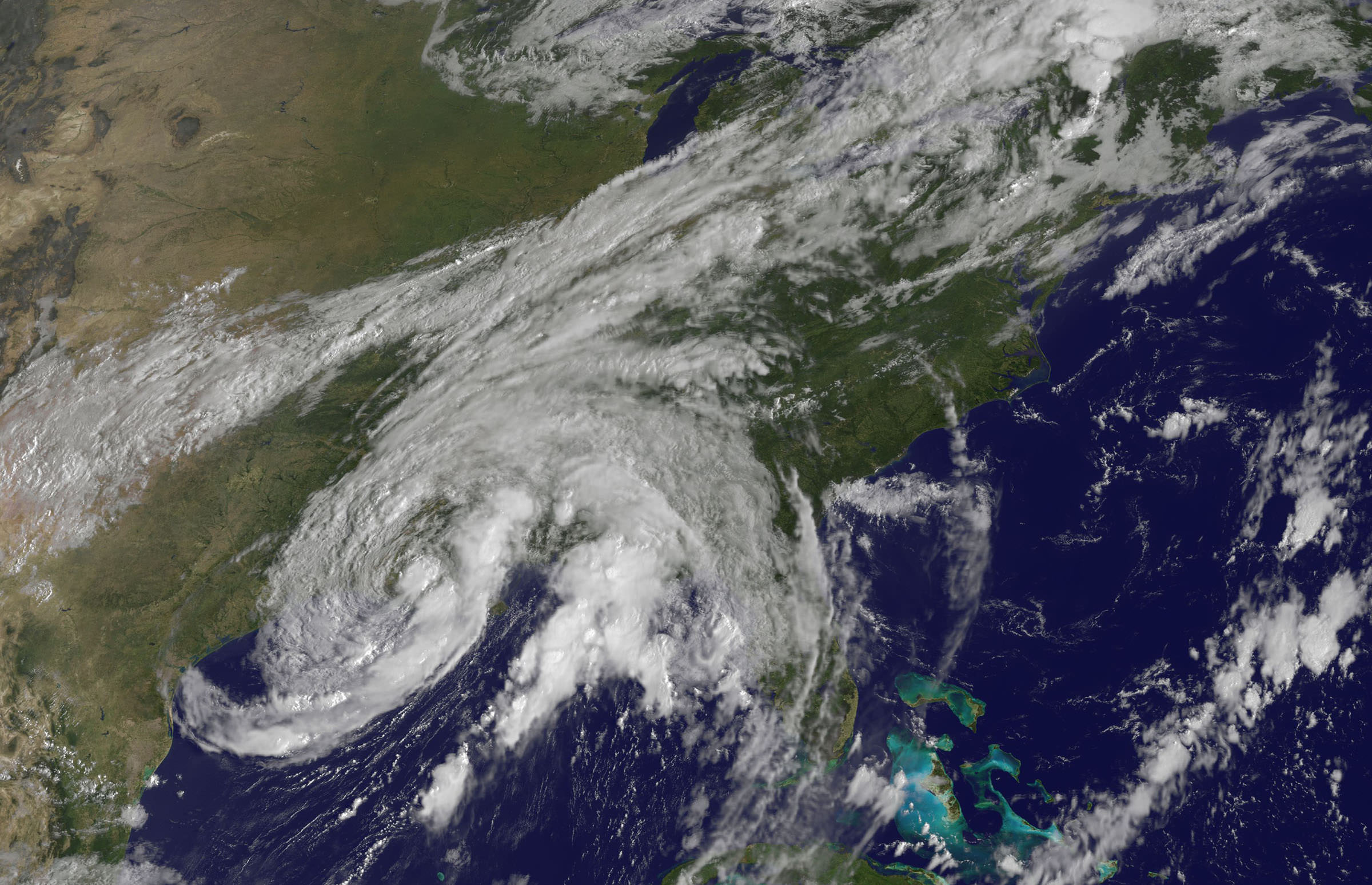
[/caption]
New imagery from NASA and NOAA satellites taken today (Sept 4) shows the extent of a hurricane season storm currently ravaging the US Gulf Coast and another potentially posing a new threat to US East Coast areas still suffering from the vast destruction caused by Hurricane Irene just days ago. Data from the NASA and NOAA satellites is critical in providing advance warning to government officials and local communities to save human lives and minimize property damage. .
Slow moving Tropical Storm Lee has unleashed strong thunderstorms and heavy rainfall in several Gulf Coast states. Rainfall amounts of up to 7 to 14 inches over the last 48 hours are currently drenching coastal and inland communities – especially in Louisiana, Mississippi and Alabama along a wide swath that extends from Texas to the Florida panhandle.
Isolated pockets of Gulf State areas may see up to 20 inches of rainfall. Severe flooding to homes and roads has occurred in some locations. Winds have diminished from 60 mph on Saturday (Sept. 3) to 45 mph on Sunday.
Imagery and measurements from the Aqua and GOES-13 satellites from NASA and NOAA revealed that TS Lee finally made landfall in Louisiana after two days of drenching rain along the Gulf Coast..
A tropical storm warning is in effect on Sept 4 for New Orleans, Lake Pontchartrain, and Lake Maurepas. Fortunately the rebuilt levees in New Orleans appear to holding in the first serious test since the vast destruction of Hurricane Katrina. Other areas are less lucky.
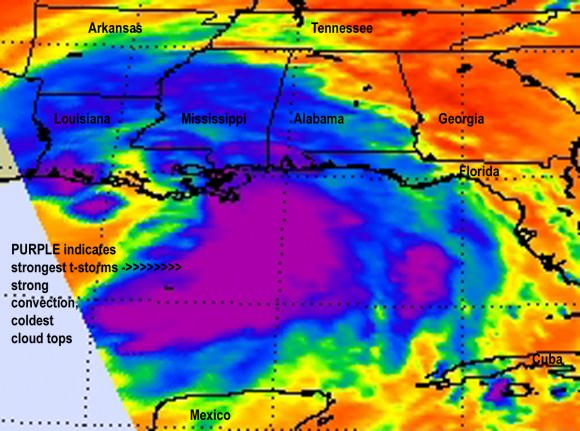
Lee’s tropical force winds now extend out 275 miles from the center. A large part of Lee is still over the Gulf of Mexico where the driving wind and rain affected operations on some oil rigs.
Lee has spawned more than a dozen tornadoes in the Gulf Coast states. The storm is spreading more heavy rain and winds on a northeast to east- northeast heading tracking towards Tennessee over the next 24 to 36 hours according to the latest weather forecasts.
Meanwhile Hurricane Katia is packing winds of 110 MPH and is on a path that could cause it to make landfall on the Outer Banks of North Carolina just a week after the state suffered from Hurricane Irene.
Hurricane Katia has the potential to affect the launch of NASA’s GRAIL Lunar Mappers slated for liftoff on Sept. 8 from Cape Canaveral, Florida, depending on its exact course.
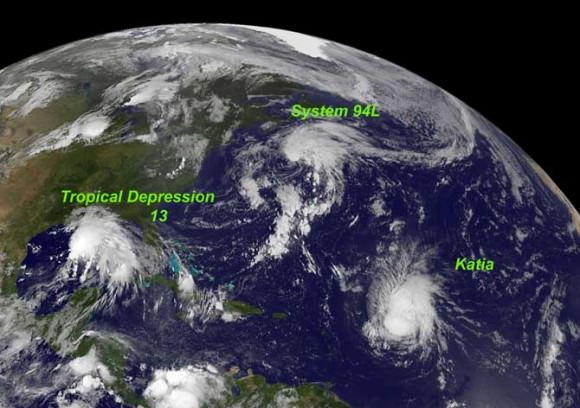
Irene caused extensive flooding and devastation on the hundred year scale in several US states still reeling from flooding and destruction. More than 43 deaths have been reported so far, including emergency rescue workers. Initial damage estimates are over $6 Billion.
Thousands of East Coast homes and businesses are still without power as strong after effects from Irene continue to play out.
President Obama toured flood stricken areas of Paterson, New Jersey today (Sept. 4).
According to a statement by Rob Gutro, of NASA’s Goddard Space Flight Center, Greenbelt, Md; Tropical Storm Lee’s winds had dropped from 60 mph exactly 24 hours before to 45 mph at 8 a.m. EDT on Sept. 4.
Lee’s center was over Vermillion Bay, Louisiana near 29.7 North and 92.0 West. It was crawling to the northeast near 3 mph (6 kmh) and expected to continue in that direction today, turning to the east-northeast tonight. Because Lee’s center is over land, he is expected to continue weakening gradually in the next couple of days. Lee’s outer bands still extend far over the Gulf of Mexico, bringing in more moisture and keeping the system going.
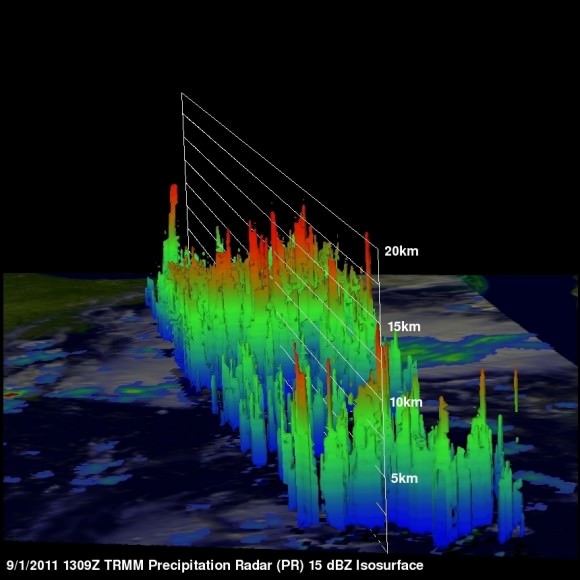
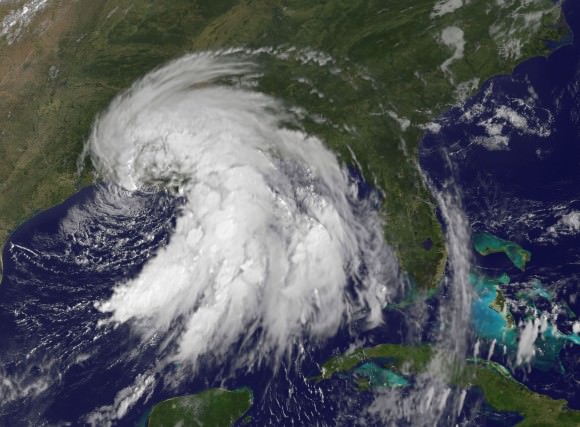
NASA – Eyes On The Solar System
Are you ready for a fascinating virtual experience? Then check out “Eyes on the Solar System”! This clever compilation of visualizations and real images takes you on a journey that’s sure to keep you entertained for hours!
If you’ve had the chance to use high dollar astronomy software, you’ll appreciate this free program. Inside is a 3-D environment full of real NASA mission data which lets you explore the cosmos from the comfort of your computer. You can choose exploring an asteroid, scouring around a planet or taking a look at Earth from above. Fly with NASA’s Voyager 2 spacecraft or join Cassini. You can even see the entire solar system moving in real time! Just check out a very small part of the features in this introductory video…
There’s so much more there, too. Imagine the possibilities of Kepler, Lunar Reconnaissance Orbiter and the Spitzer Space Telescope! Move forward and backward in time… You’re in command of this space journey! According to the developers, the awesome modeling team is currently working on a number of spacecraft models. In the near future, expect to see finished models of Phoenix (cruise), Mars Exploration Rovers (cruise), Mars Science Laboratory (cruise), Mars Odyssey, and Mars Express. There are many spacecraft in the pipeline, so be patient!
While NASA’s “Eyes on the Solar System” is compatible with Windows and Mac OS X, the partially Java-scripted format has a certain dependence on what browser is used. Firefox is recommended for smoothest operation, but it also works with IE and Safari. (I personally use Opera and encountered no problems – but avoid Chrome.) Other than that? Grab and comfy seat and take flight!
NASA Robot arrives at ‘New’ Landing Site holding Clues to Ancient Water Flow on Mars
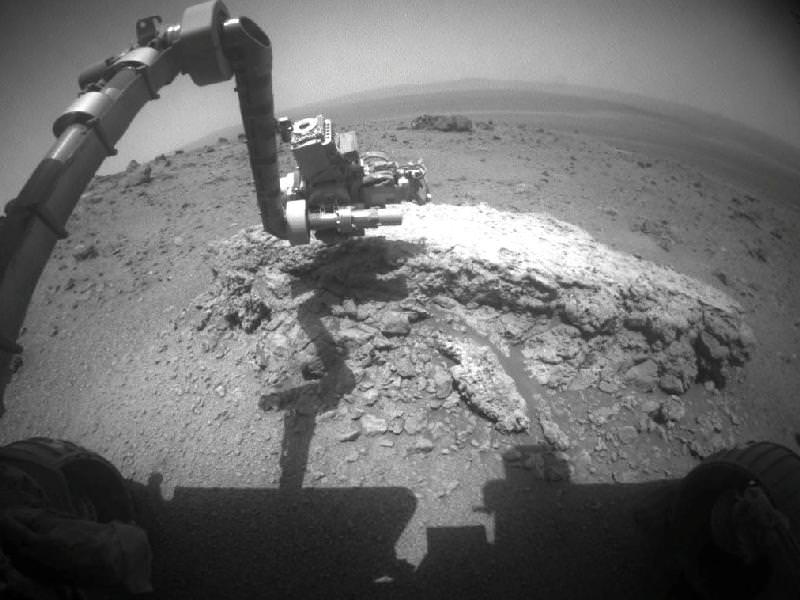
[/caption]
Opportunity has begun a whole new mission at the vast expanse of Endeavour Crater promising a boatload of new science discoveries.
Scientists directing NASA’s Mars Opportunity rover gushed with excitement as they announced that the aging robot has discovered a rock with a composition unlike anything previously explored on the Red Planet’s surface – since she landed on the exotic Martian plains 7.5 years ago – and which offers indications that liquid water might have percolated or flowed at this spot billions of years ago.
Barely three weeks ago Opportunity arrived at the rim of the gigantic 14 mile ( 22 km) wide crater named Endeavour after an epic multi-year trek, and for the team it’s literally been like a 2nd landing on Mars – and the equivalent of the birth of a whole new mission of exploration at an entirely ‘new’ landing site.
“This is like having a brand new landing site for our veteran rover,” said Dave Lavery, program executive for NASA’s Mars Exploration Rovers at NASA Headquarters in Washington. “It is a remarkable bonus that comes from being able to rove on Mars with well-built hardware that lasts.”
Opportunity has traversed an incredible distance of 20.8 miles (33.5 km) across the Meridiani Planum region of Mars since landing on January 24, 2004 for a 3 month mission – now 30 times longer than the original warranty.
“Tisdale 2” is the name of the first rock that Opportunity drove to and investigated after reaching Endeavour crater and climbing up the rim at a low ridge dubbed ‘Cape York’.
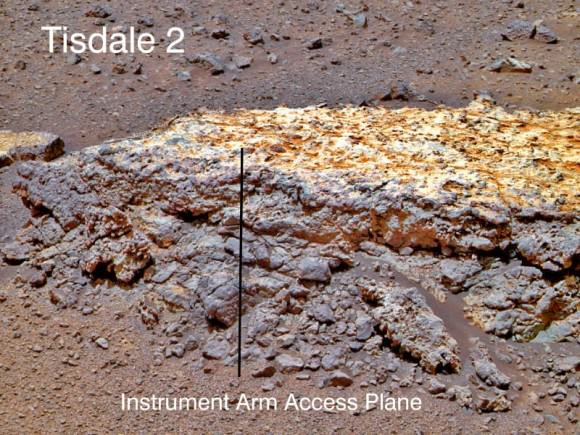
Endeavour’s rim is heavily eroded and discontinuous and divided into a series of segmented and beautiful mountainous ridges that offer a bonanza for science.
“This is not like anything we’ve ever seen before. So this is a new kind of rock.” said Steve Squyres, principal investigator for Opportunity at Cornell University in Ithaca, N.Y at a briefing for reporters on Sept. 1.
“It has a composition similar to some volcanic rocks, but there’s much more zinc and bromine than we’ve typically seen. We are getting confirmation that reaching Endeavour really has given us the equivalent of a second landing site for Opportunity.”
Tisdale 2 is a flat-topped rock about the size of a footstool that was blasted free by the impact that formed the tennis court sized “Odyssey” crater from which it was ejected.
“The other big take-away message, and this is to me the most interesting thing about Tisdale, is that this rock has a huge amount of zinc in it, way more zinc than we have ever seen in any Martian rock. And we are puzzling, we are thinking very hard over what that means,” Squyres speculated.
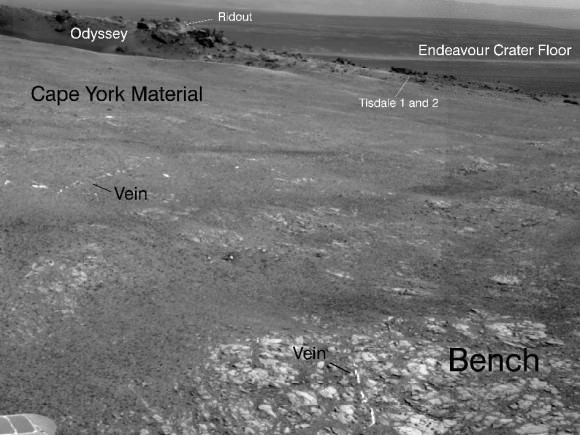
Squyres said that high levels of zinc and bromine on Earth are often associated with rocks in contact with flowing water and thus experiencing hydrothermal activity and that the impact is the source of the water.
“When you find rocks on Earth that are rich in zinc, they typically form in a place where you had some kind of hydrothermal activity going on, in other words, you have water that gets heated up and it flows through the rocks and it can dissolve out and it can get redeposited in various places,” Squyres explained.
“So this is a clue, not definitive proof yet, but this is a clue that we may be dealing with a hydrothermal system here, we may be dealing with a situation where water has percolated or flowed or somehow moved through these rocks, maybe as vapor, maybe as liquid, don’t know yet.”
“But it has enhanced the zinc concentration in this rock to levels far in excess of anything we’ve ever seen on Mars before. So that’s the beginning of what we expect is going to be a long and very interesting story about these rocks.”
Endeavour crater was chosen three years ago as the long term destination for Opportunity because it may hold clues to a time billions and billions of years ago when Mars was warmer and wetter and harbored an environment that was far more conducive to the formation of life beyond Earth.
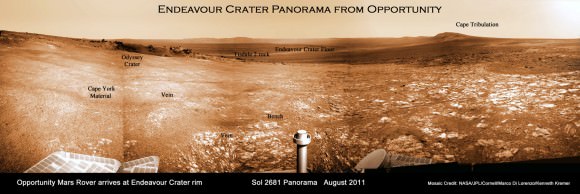
Opportunity arrived at the rim of Endeavour on Sol 2681, August 9, 2011 and climbed up the ridge known as Cape York. Odyssey crater is visible at left. The rover has driven to Tisdale 2 rock at the outskirts of Odyssey to investigate the ejecta blocks which may hold clues to ancient water flow on Mars. Distant portions of Endeavour’s rim - as far as 13 miles away – visible in the background. The rover will likely drive eventually to the Cape Tribulation rim segment at right which holds a mother lode of clay minerals. This photo mosaic was stitched together from raw images taken by Opportunity on Sol 2681.
Mosaic Credit: NASA/JPL/Cornell/Marco Di Lorenzo/Kenneth Kremer
Signatures of clay minerals, or phyllosilicates, were detected at several spots at Endeavour’s western rim by observations from the Compact Reconnaissance Imaging Spectrometer for Mars (CRISM) aboard NASA’s Mars Reconnaissance Orbiter (MRO).
“The motherlode of clay minerals is on Cape Tribulation. The exposure extends all the way to the top, mainly on the inboard side,” said Ray Arvidson, the rover’s deputy principal investigator at Washington University in St. Louis.
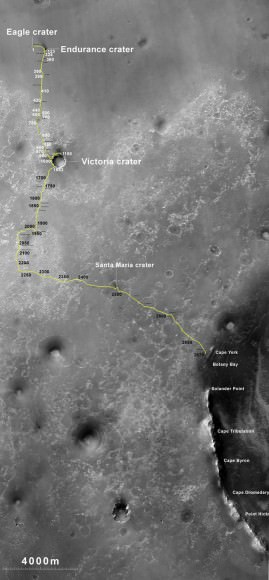
Phyllosilicates are clay minerals that form in the presence of pH neutral water and which are far more hospitable to the possible genesis of life compared to the sulfate rich rocks studied in the more highly acidic aqueous environments examined by both the Opportunity and Spirit rovers thus far.
“We can get up the side of Cape Tribulation,” said Arvidson. It’s not unlike Husband Hill for Spirit. We need to finish up first at Cape York, get through the martian winter and then start working our way south along Solander Point.
The general plan is that Opportunity will probably spend the next several months exploring the Cape York region for before going elsewhere. “Just from Tisdale 2 we know that we have something really new and different here,” said Squyres.
“On the final traverses to Cape York, we saw ragged outcrops at Botany Bay unlike anything Opportunity has seen so far, and a bench around the edge of Cape York looks like sedimentary rock that’s been cut and filled with veins of material possibly delivered by water,” said Arvidson. “We made an explicit decision to examine ancient rocks of Cape York first.”
So far at least the terrain at Cape York looks safe for driving with good prospects for mobility.
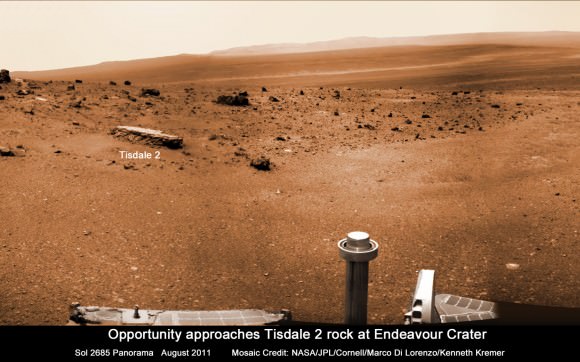
Opportunity Mars rover climbed up the ridge known as Cape York and drove to the flat topped Tisdale 2 rock at upper left to analyze it with the science instruments on the robotic arm. This photo mosaic was stitched together from raw images taken by Opportunity on Sol 2685, August 2011.
Mosaic Credit: NASA/JPL/Cornell/Marco Di Lorenzo/Kenneth Kremer
“The good news is that, as predicted, we have hard packed soils like the plains at Gusev that Spirit saw before getting to the Columbia Hills,” said Arvidson. “The wheel tracks at Cape York are very, very shallow. So if anything we will have some skid going downhill the slopes of 5 to 10 degrees on the inboard side which we can correct for.”
“We are always on the lookout for sand traps. We are particularly sensitized to that after the Spirit situation. So far it’s clear sailing ahead.”
Opportunity will then likely head southwards towards an area dubbed “Botany Bay” and eventually drive some 1.5 km further to the next ridge named Cape Tribulation and hopefully scale the slopes in an uphill search for that mother lode of phyllosilicates.
“My strong hope – if the rover lasts that long – is that we will have a vehicle that is capable of climbing Cape Tribulation just as we climbed Husband Hill with Spirit. So it’s obvious to try if the rover is capable, otherwise we would try something simpler. But even if we lose a wheel we still have a vehicle capable of a lot of science,” Squyres emphasized. “Then we would stick to lower ground and more gently sloping stuff.”
“The clear intention as we finish up at Cape York, and look at what to do next, is that we are going to work our way south. We will focus along the crater’s rim. We will work south along the rim of Endeavour unless some discovery unexpectedly causes us to do something else.”
“We will go where the science takes us !” Squyres stated.
Opportunity is in generally good health but the rover is showing signs of aging.
“All in all, we have a very senior rover that’s showing her age, she has some arthritis and some other issues but generally, she’s in good health, she’s sleeping well at night, her cholesterol levels are excellent and so we look forward to productive scientific exploration for the period ahead,” said John Callas, project manager for Opportunity at NASA’s Jet Propulsion Laboratory in Pasadena, Calif.
“This has the potential to be the most revealing destination ever explored by Opportunity,” said Lavery. “This region is substantially different than anything we’ve seen before. We’re looking at this next phase of Opportunity’s exploration as a whole new mission, entering an area that is significantly different in the geologic context than anything we’ve seen with the rovers.”
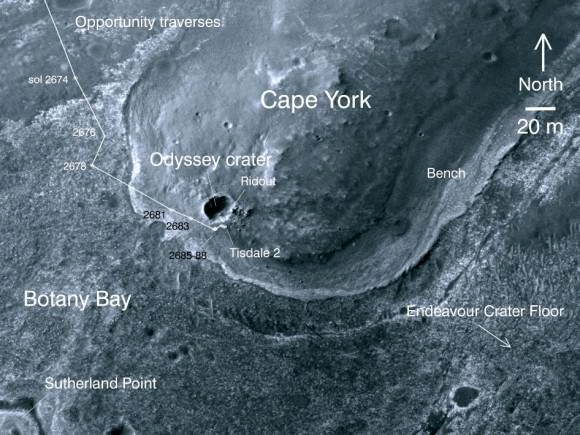
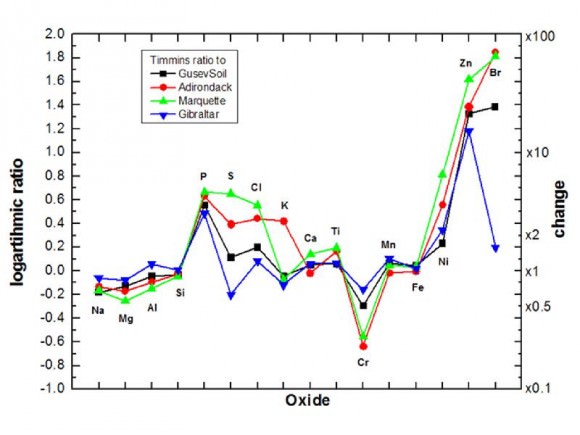
Read Ken’s continuing features about Mars starting here
Opportunity Arrives at Huge Martian Crater with Superb Science and Scenic Outlook
Opportunity Snaps Gorgeous Vistas nearing the Foothills of Giant Endeavour Crater
Dramatic New NASA Animation Depicts Next Mars Rover in Action
Opportunity Rover Heads for Spirit Point to Honor Dead Martian Sister; Science Team Tributes
Opportunity Rover Completes Exploration of fascinating Santa Maria Crater
Opportunity Surpasses 30 KM Driving and Snaps Skylab Crater in 3 D
Book Review: Lunar and Planetary Rovers

[/caption]
Ordinarily if a book attempts to cover crewed and unmanned missions – the book is a compilation of space flight history in general. This is not the case when it comes to Springer/Praxis’ offering Lunar and Planetary Rovers. Written by Anthony Young, the book details both crewed (the Apollo “J” missions) and unmanned rovers (Pathfinder, Mars Exploration Rovers and Curiosity). The book is not a perfect blending of the two interconnected, yet separate programs – but it does have much to offer.
First published in 2010, the book is a well-researched, detailed account of the lunar rovers that flew on Apollos 15, 16 and 17 and the robotic explorers that have scoured the face of the red planet – Mars.
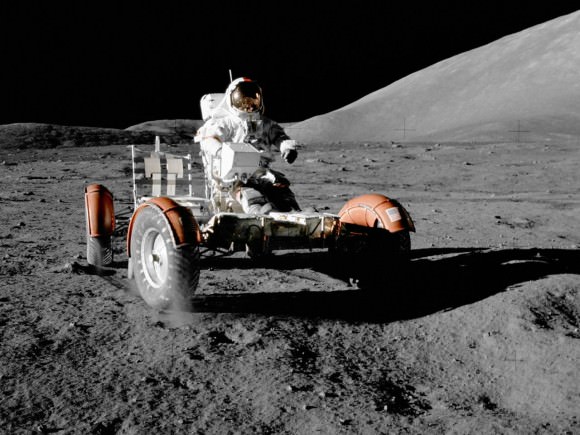
Lunar and Planetary Rovers fills a need for an account of efforts to get wheels on other worlds. The book is filled with numerous photographs (both color and black and white) that have never been published before. In terms of the Apollo Program, Lunar and Planetary Rovers is replete with quotes from the astronauts that drove the lunar rovers on the Moon. In terms of the unmanned planetary rovers, the book pulls from the engineers and scientists that made (and make) these machines work.
The book is 305 pages long. It could have stood to be a few pages longer. One glaring omission in the general body of the book is that of the Lunokhods (these amazing machines are mentioned in the appendix of the book). Given that the Lunokhods bridge the gap between the Apollo Program’s manned lunar rovers (in that they both rolled across the lunar regolith) and the robotic planetary rovers – this is a fairly significant gap in coverage of the topic. The book also does not tie these two, separate, programs together very well (the jump from one topic to the other is jarring and not done consistently).
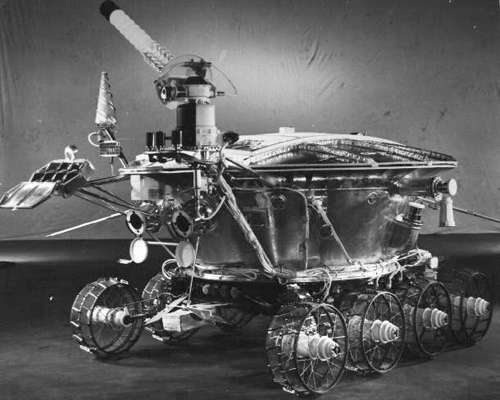
Even when one considers this slight flaw – the book still provides an accurate and useful history of rovers. Lunar and Planetary Rovers can be purchased on the secondary market (Amazon) for approximately $5 (that is including shipping and handling) the book is a good buy for those wanting information concerning the topic. For those that are not interested in the traditional, paper, format a Kindle edition is available for around $25.
With the launch of the Mars Science Laboratory (MSL) or Curiosity as it is more commonly known currently scheduled to take place this November – this book serves as a historical reminder as to how the technology employed by Curiosity was both developed and refined.
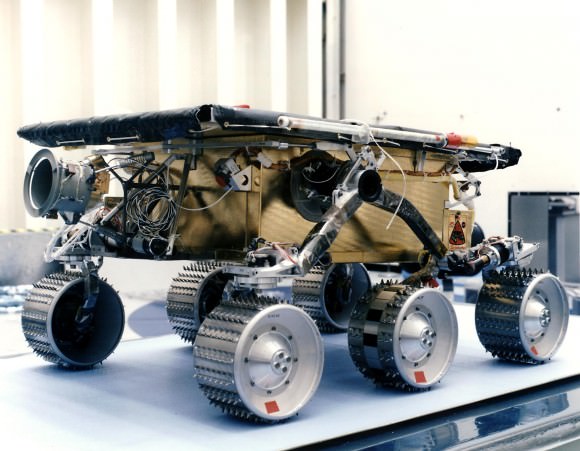
James Webb Space Telescope Nearing Completion
[/caption]
The James Webb Space Telescope or JWST has long been touted as the replacement for the Hubble Space Telescope. The telescope is considered to be the one of the most ambitious space science projects ever undertaken – this complexity may be its downfall. Cost overruns now threaten the project with cancellation. Despite these challenges, the telescope is getting closer to completion. As it stands now, the telescope has served as a technical classroom on the intricacies involved with such a complex project. It has also served to develop new technologies that are used by average citizens in their daily lives.
Although compared to Hubble, the two telescopes are dissimilar in a number of ways. The JWST is three times as powerful as Hubble in its infrared capabilities. JWST’s primary mirror is 21.3 feet across (this provides about seven times the amount of collecting power that Hubble currently employs).
The JWST’s mirrors were polished using computer modeling guides that allowed engineers to predict that they will enter into the proper alignment when in space. Each of the mirrors on the JWST has been smoothed down to within 1/1000th the thickness of a human hair. The JWST traveled to points across the country to assemble and test the JWST’s various components.
Eventually the mirrors were then sent to NASA’s Marshall Space Flight Center in Huntsville, Alabama. Once there they measured how the mirrors reacted at extremely cold temperatures. With these tests complete, the mirrors were given a thin layer of gold. Gold is very efficient when it comes to reflecting light in the infrared spectrum toward the JWST’s sensors.
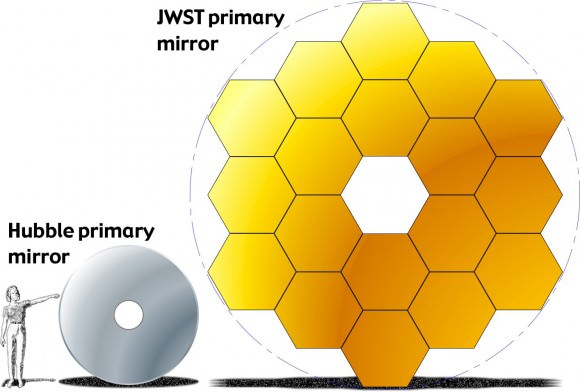
The telescope’s array of mirrors is comprised of beryllium, which produces a lightweight and more stable form of glass. The JWST requires lightweight yet strong mirrors so that they can retain their shape in the extreme environment of space. These mirrors have to be able to function perfectly in temperatures reaching minus 370 degrees Fahrenheit.
After all of this is done, still more tests await the telescope. It will be placed into the same vacuum chamber that tested the Apollo spacecraft before they were sent on their historic mission’s to the moon. This will ensure that the telescopes optics will function properly in a vacuum.
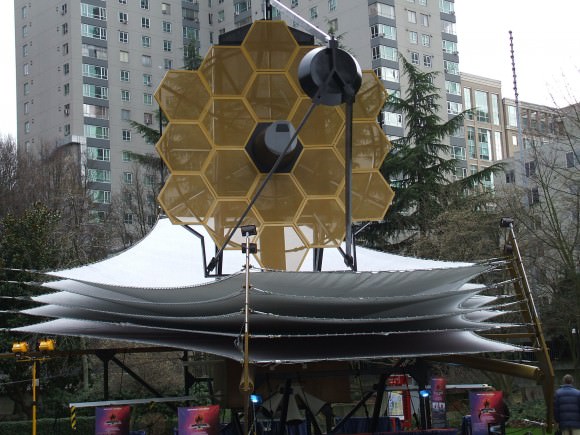
With all of the effort placed into the JWST – a lot of spinoff technology was developed that saw its way into the lives of the general populace. Several of these – had to be invented prior to the start of the JWST program.
“Ten technologies that are required for JWST to function did not exist when the project was first planned, and all have been successfully achieved. These include both near and mid-infrared detectors with unprecedented sensitivity, the sunshield material, the primary mirror segment assembly, the NIRSpec microshutter array, the MIRI cryo-cooler, and several more,” said the James Webb Space Telescope’s Deputy Project Scientist Jason Kalirai. Kalirai holds a PhD in astrophysics and carries out research for the Space Telescope Science Institute. “The new technologies in JWST have led to many spinoffs, including the production of new electric motors that outperform common gear boxes, design for high precision optical elements for cameras and cell phones, and more accurate measurements of human vision for people about to undergo Laser Refractive Surgery.”
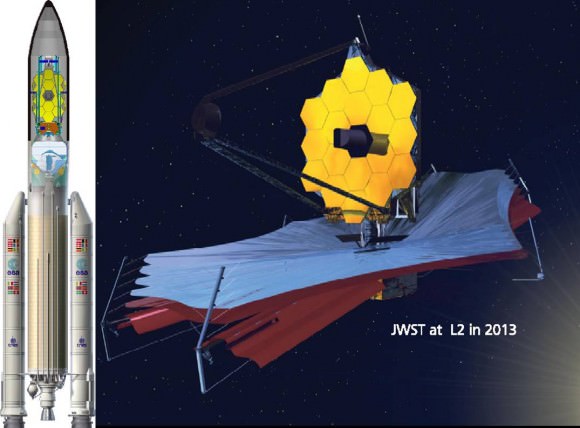
If all goes according to plan, the James Webb Space Telescope will be launched from French Guiana atop the European Space Agency’s Arianne V Rocket. The rationale behind the Ariane V’s selection was based on capabilities – and economics.
“The Ariane V was chosen as the launch vehicle for JWST at the time because there was no U.S. rocket with the required lift capacity,” Kalirai said. “Even today, the Ariane V is a better tested vehicle. Moreover, the Ariane is provided at no cost by the Europeans while we would have had to pay for a U.S. rocket.”
It still remains to be seen as to whether or not the JWST will even fly. As of July 6 of this year the project is slated to be cancelled by the United States Congress. The James Webb Space Telescope was initially estimated at costing $1.6 billion. As of this writing an estimated $3 billion has been spent on the project and it is has been estimated that the telescope is about three-quarters complete.
Two Into The Blue: One Engineer’s Gemini Reflections
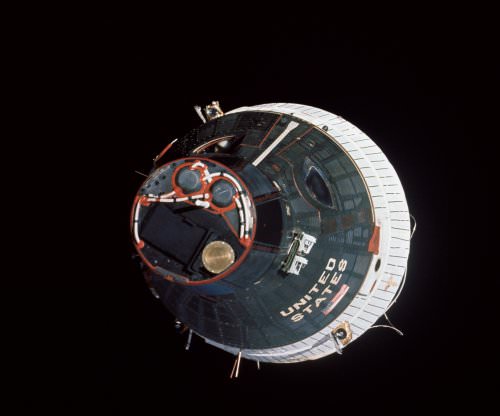
[/caption]
It is probably one of the least understood, but most crucial, (in terms of landing a man on the Moon) programs in U.S. space flight history. After just fifteen minutes in space (and all of it sub-orbital) President John F. Kennedy tasked NASA with sending astronauts to the lunar surface. NASA completed the Mercury Program and moved on to Gemini, which had a crew of two and would work to teach NASA the most basic elements of space flight.
Extravehicular activity (EVA), rendezvous and dealing with the microgravity environment were all issues tackled by NASA on the Gemini Program. Gemini was essentially NASA’s “classroom” – teaching the space agency the lessons needed to fly to the Moon.
Most books on Gemini follow the basic path, an overall of all spaceflight efforts and then a chronological history of the program and how it taught NASA how to live and work in space. Two into the Blue – breaks from this mold and tells the Gemini story from one engineer’s perspective, sharing along the way his thoughts and feelings during this time.
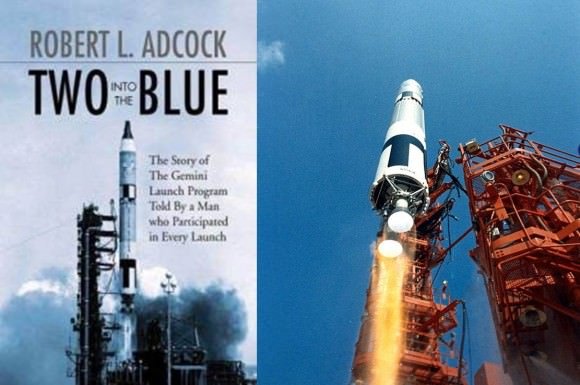
Two into the Blue is written by Robert L. Adcock, published by Xlibris Corp and weighs in at a light 142 pages. Adcock worked for about 36 years within the Aerospace Industry, his earliest experiences coincided with the development of rockets and the spacecraft that were among the first that the U.S. sent into orbit. Adcock grew up in Tennessee, graduated from the University with a BSEE and followed with a Doctorate in Business Administration that he received from Florida State in 1977.
Two into the Blue details Adcock’s experiences during this crucial time for the U.S. space program. The book is largely written from his perspective, telling his experiences during NASA’s Gemini years. Given that most books discussing the Mercury, Gemini and Apollo Programs are essentially identical in format makes Two into the Blue a welcome departure with new details and fresh stories. Adcock participated in some capacity every one of the Gemini Program’s ten flights.
Each of the Gemini missions was dedicated to techniques that would pave the way for the Apollo flights to the Moon. Without the Gemini series of missions, NASA would never have been able to learn all of the techniques needed to send a man to the Moon and return him safely to the Earth. Despite its vital role, Gemini is largely forgotten by most of the general public today. With NASA’s current future uncertain, this book allows one to look back to a time when the U.S. crewed space flight program’s future was bright.
Two into the Blue is a short read, but it is a great book for someone preparing to take a trip and who will be stuck in an airport or in a car. It’s also great for space enthusiasts seeking to find out more about the Gemini Program and the history that surrounded these important missions.
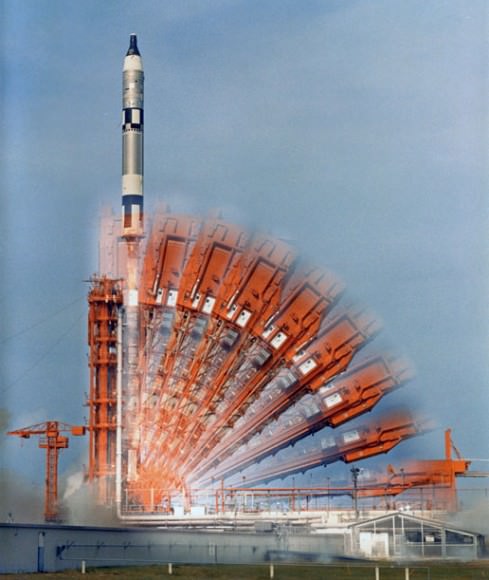
Space Debris Problem Getting Worse, New Report Says
[/caption]
In the movie WALL-E, the Earth is surrounded by a dense field of orbiting junk. The problem of space debris is not that bad yet, but is potentially heading in that direction. A new report released today by the National Research Council says the problem of space debris is getting worse and has passed a “tipping point.” The report says that while NASA has done a good job using their available resources to research the issue, decreased funding and increased responsibilities for the space agency is not a good combination for the future, and NASA has not been able to keep pace with increasing hazards posed by abandoned equipment, spent rocket bodies, and other debris orbiting the Earth.
“The current space environment is growing increasingly hazardous to spacecraft and astronauts,” said Donald Kessler, chair of the committee that wrote the report and retired head of NASA’s Orbital Debris Program Office. “NASA needs to determine the best path forward for tackling the multifaceted problems caused by meteoroids and orbital debris that put human and robotic space operations at risk.”
There’s enough debris currently in orbit to continually collide and create even more debris, raising the risk of spacecraft failures, the report notes. In addition, collisions with debris have disabled and even destroyed satellites in the past, as in the collision in 2009 between an Iridium satellite and a inoperative Russian satellite. Several recent near-misses of the International Space Station requiring evasive maneuvers and sending astronauts to the Soyuz vehicles as a precaution underscores the value in monitoring and tracking orbital debris as precisely as possible.
It is fitting that Kessler lead this committee: he laid out a scenario back in 1978 called the Kessler Syndrome where the amount and size of objects in Earth’s orbit could eventually become so large that they would continually collide with one another and create even more debris, eventually causing a “cascade” of collisions which could make low Earth orbit unusable for decades.
From the new report, it appears the Kessler Syndrome is not just an abstract event that might occur in the future. It’s happening now. The amount of debris is now growing exponentially, as just two collisions since January 2007 has doubled the total number of debris fragments in Earth’s orbit, according to the NRC report.
NASA had asked for the report; specifically, NASA’s chief of safety and mission assurance, Bryan O’Connor, asked the NRC in 2010 to independently examine the agency’s work on debris.
“We thank the National Research Council for their thorough review in this report,” said NASA spokeswoman Beth Dickey. “We will study their findings and recommendations carefully and use them to advise our future actions in this important area of work.”
The report, however, does not provide NASA with many specific ideas but says NASA should develop a formal strategic plan to better allocate its limited resources devoted to the management of orbital debris. In addition, removal of debris from the space environment or other actions to mitigate risks may be necessary.
For example, NASA should initiate a new effort to record, analyze, report, and share data on spacecraft anomalies. This will provide additional knowledge about the risk from debris particulates too small to be cataloged under the current system yet large enough to potentially cause damage.
The report also suggests more work internationally on this problem, since it is a global problem caused by other nations besides the US. Over the past decade and a half, the world’s major space agencies have been developing a set of orbital debris mitigation guidelines aimed at stemming the creation of new space debris and lessening the impact of existing debris on satellites and human spaceflight. Most agencies are in the process of implementing or have already implemented these voluntary measures which include on-board passive measures to eliminate latent sources of energy related to batteries, fuel tanks, propulsion systems and pyrotechnics.
But the growing number of developing countries that are launching using satellites, and they need to be encouraged to use these measures as well.
In addition, NASA should lead public discussion of orbital debris and emphasize that it is a long-term concern for society that must continue to be addressed.
Congress also needs to be aware of the problem and provide adequate funding for the issue.
You can read the report here. (free as a pdf download).
Sources: NRC press release, Washington Post
NASAs Lunar Mapping Duo Encapsulated and Ready for Sept. 8 Liftoff
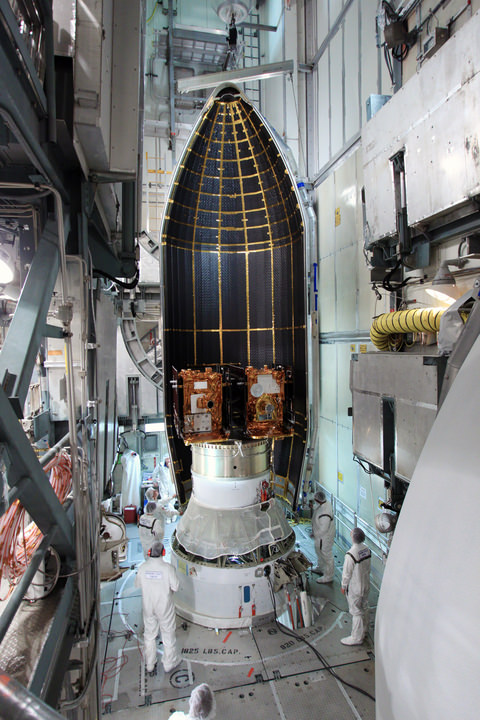
[/caption]
NASA’s powerful lunar mapping duo of GRAIL spacecraft are now poised for liftoff in just one weeks time on Thursday, Sept. 8.
Mission managers held a Flight Readiness Review on Wednesday (Aug.31) and gave a tentative approval to begin fueling the Delta II rockets second stage on Sept. 2 and 3 after evaluating all issues related to the rocket, launch pad and payloads.
Launch preparations are proceeding on schedule towards an early morning lift off from the seaside Space Launch Complex 17B (SLC-17B) at Cape Canaveral Air Force Station, Florida. There are two instantaneous launch windows at 8:37:06 a.m. and 9:16:12 a.m. EDT lasting one second each.
“Launch vehicle and spacecraft closeouts will begin on Tuesday, and the Launch Readiness Review is also scheduled for Tuesday morning,” NASA KSC spokesman George Diller told Universe Today.
“This morning’s launch countdown dress rehearsal went fine.”
“Delta II 2nd stage fueling has been rescheduled for Friday and Saturday [Sept. 2 and 3]. Last evening a software error was found in the launch processing system data base. ULA (United Launch Alliance) decided they would like to look for any additional errors before the fueling begins. There is no impact to the launch date and currently no work is scheduled on Sunday or on Labor Day,” said Diller.
The launch period extends through Oct. 19, with liftoff occurring approximately four minutes earlier each day in case of a delay. The flight plan was designed to avoid a pair of lunar eclipses occurring on December 10th, 2011 and June 4th 2012 which would interfere with the missions operations and science.
The team is keeping a close watch on the weather as the season’s next Atlantic Ocean storm heads westwards. Katia has just been upgraded to Hurricane status and follows closely on the heels of the continuing vast destruction, misery and deaths caused by Hurricane Irene earlier this week.
“The preliminary weather forecast is favorable for launch day as long as the wind remains out of the west as is currently forecast for that time of the morning,” Diller told me.
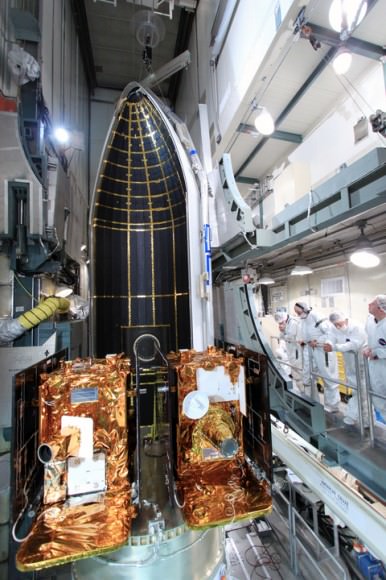
The twin probes known as GRAIL-A and GRAIL-B (Gravity Recovery and Interior Laboratory) were encapsulated inside the clamshell like payload fairing on Aug. 23 The nearly identical spacecraft are mounted side by side and sit atop the Centaur upper stage.
The fairing shields the spacecraft from aerodynamic pressures, friction and extreme heating for the first few minutes of flight during ascent through the Earth atmosphere.
This Delta II Heavy booster rocket is the most powerful version of the Delta II family built by ULA. The booster’s first stage is augmented with larger diameter solid rocket motors.
GRAIL was processed for launch inside at the Astrotech payload processing facility in Titusville, Fla. See my GRAIL spacecraft photos from inside the Astrotech clean room facilities here.
“The GRAIL spacecraft inside the handling can departed Astrotech and arrived at the launch pad, SLC-17B on Aug. 18” said Tim Dunn, NASA’s Delta II Launch Director in an interview with Universe Today. “The spacecraft was then hoisted by crane onto the Delta II launch vehicle and the spacecraft mate operation was flawlessly executed by the combined ULA and NASA Delta II Team.”
An Integrated Systems Test (IST) of the mated booster and payload was completed on Aug. 22
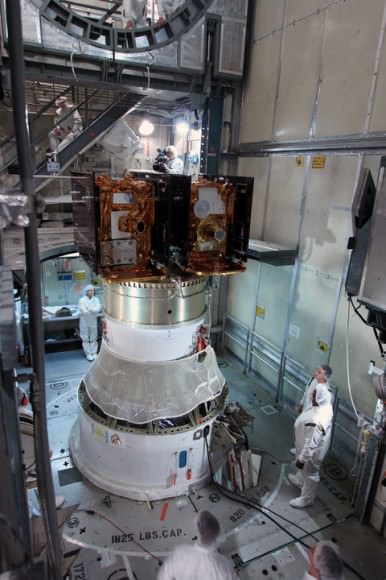
The dynamic duo will orbit the moon in a tandam formation just 50 kilometers above the lunar surface with an average separation of 200 km. During the 90 day science phase the goal is to determine the structure of the lunar interior from crust to core and to advance understanding of the thermal evolution of the moon.
GRAIL-A & GRAIL-B will measure the lunar gravity field with unprecedented resolution up to 100 times improvement on the near side and 1000 times improvement for the far side.
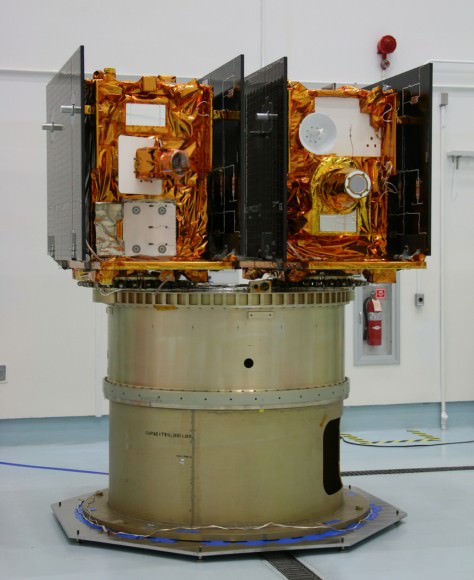
GRAIL B (left) and GRAIL A (right) spacecraft are mounted side by side on top of a payload adapter inside the clean room at Astrotech Space Operations facility. The spacecraft await lunar launch on Sept. 8, 2011. Credit: Ken Kremer
Read Ken’s continuing features about GRAIL
GRAIL Lunar Twins Mated to Delta Rocket at Launch Pad
GRAIL Twins ready for NASA Science Expedition to the Moon: Photo Gallery
First Image Captured by NASAs Jupiter bound Juno; Earth – Moon Portrait
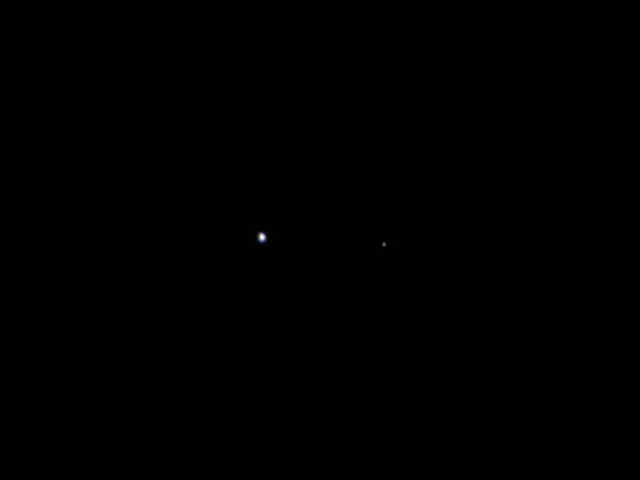
[/caption]
NASA’s solar powered Jupiter bound Juno orbiter has captured her first image – a beautiful portrait of the Earth & Moon – since the probe blasted off from the home planet.
Juno lifted off 25 days ago at 12: 25 p.m. on August 5 from Space Launch Complex 41 at Cape Canaveral Air Force Station in Florida. The spacecraft snapped the portrait with the onboard JunoCam camera on August 26 after journeying some 6 million miles (9.66 million km) from Earth and while traveling at a velocity of 77,600 miles per hour (124,900 kilometers per hour) relative to the sun.
“The image of the Earth Moon system is a rather unique perspective that we can get only by stepping outside of our home planet,” said Scott Bolton, Juno principal investigator, in an exclusive interview with Universe Today. Bolton is from the Southwest Research Institute in San Antonio.
“On our way to Jupiter, we’ve looked back at home and managed to take this amazing image.”
“Earth looking much like any other planet or star from a distance is glorious as this somewhat average looking “star” is home to all of humanity. Our companion, the moon, so beautiful and important to us, stands out even less.”
“We appear almost average and inconspicuous, yet all of our history originates here. It makes one wonder just how many other planets or solar systems might contain life like ours,” Bolton told me.
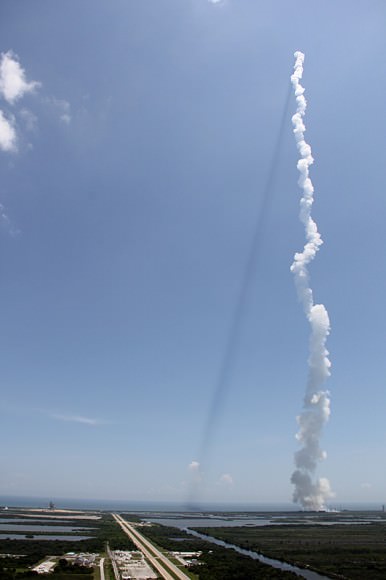
The Juno team commanded the probe to take the image as part of the checkout phase of the vehicles instruments and subsystems.
“The JunoCam instrument turn on and check out were planned activities. The instrument is working great and in fact, all the instruments that we’ve turned on thus far have been working great,” Bolton added.
So far the spacecraft is in excellent health and the team has completed the checkout of the Waves instrument and its two Flux Gate Magnetometer sensors and deployment of its V-shaped electric dipole antenna.
“We have a couple more instruments still to do,” Bolton noted.
The team reports that Juno also performed its first precession, or reorientation maneuver, using its thrusters and that the first trajectory control maneuver (TCM-1) was cancelled as unnecessary because of the extremely accurate targeting provided by the Atlas V rocket.
The portrait shot is actually not Juno’s last photo of her home.
The 8000 pound (3,600 kilogram) probe will fly by Earth once more on October 9, 2013 for a gravity assisted speed boost of 16,330 MPH (7.3 km/sec) to accelerate Juno past the asteroid belt on its long journey to the Jovian system.

JunoCam will collect new photos and the other science instruments will make measurements as Juno cartwheels past Earth during the slingshot to Jupiter.
Juno is on a 5 year and 1.7 Billion mile (2.8 Billion km) trek to the largest planet in our solar system. When she arrives at Jupiter on July 4, 2016, Juno will become the first polar orbiting spacecraft at the gas giant.
During a one year science mission – entailing 33 orbits lasting 11 days each – the probe will plunge to within about 3000 miles (5000 km) of the turbulent cloud tops and collect unprecedented new data that will unveil the hidden inner secrets of Jupiter’s genesis and evolution.
The goal is to find out more about the planets origins, interior structure and atmosphere, observe the aurora, map the intense magnetic field and investigate the existence of a solid planetary core.
“This is a remarkable sight people get to see all too rarely,” said Bolton in a NASA statement about the Earth-Moon photo. “This view of our planet shows how Earth looks from the outside, illustrating a special perspective of our role and place in the universe. We see a humbling yet beautiful view of ourselves.”
NASA’s Jet Propulsion Laboratory manages the Juno mission. The spacecraft was designed and built by Lockheed Martin Space Systems, Denver.
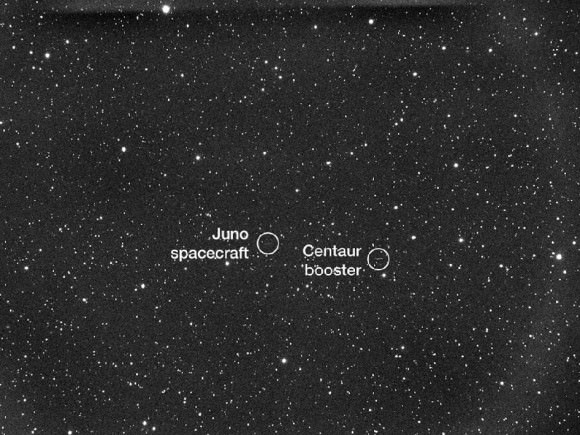
NASA's Juno spacecraft and its spent Centaur upper rocket stage are captured in this telescope view as they move across the field of stars. The five-minute, timed exposure was acquired on Aug. 5 11:18pm Eastern time (Aug. 6 at 3:18 UTC) when Juno was at a distance of about 195,000 miles (314,000 kilometers) from Earth. The images were taken remotely by amateur astronomer Scott Ferguson using Global Rent-a-Scope's GRAS-016 Takahashi Widefield Refractor, which is located in Nerpio, Spain. Credit: Scott Ferguson
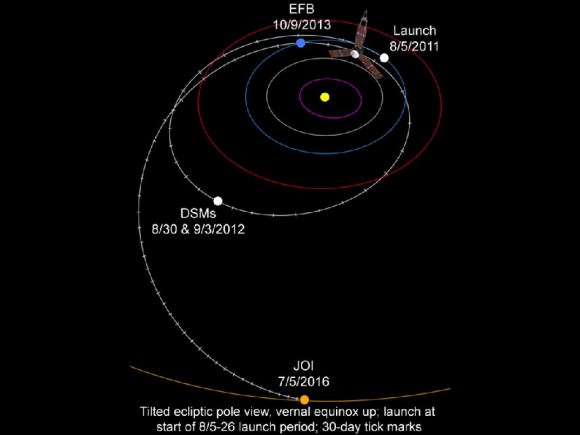
This graphic shows Juno's trajectory, or flight path, from Earth to Jupiter. The spacecraft travels around the Sun, to a point beyond the orbit of Mars where it fires its main engine a couple of times. These deep space maneuvers set up the Earth flyby maneuver that occurs approximately two years after launch. The Earth flyby gives Juno the boost in velocity it needs to coast all the way to Jupiter. Juno arrives at Jupiter in July 2016. Credit: NASA/JPL-Caltech
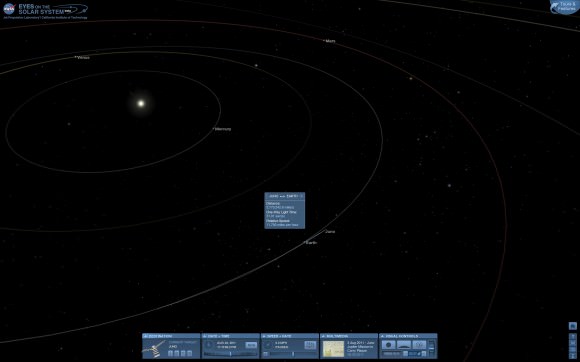
Read my continuing features about Juno
Juno Blasts off on Science Trek to Discover Jupiter’s Genesis
Juno Jupiter Orbiter poised at Launch Pad for Aug. 5 Blastoff
JUNO Orbiter Mated to Mightiest Atlas rocket for Aug. 5 Blastoff to Jupiter
Solar Powered Jupiter bound JUNO lands at Kennedy Space Center


